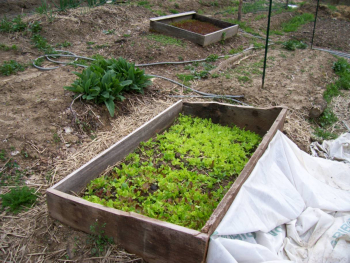
Planting for a Four Season Harvest, Part 9
Mid-Summer
Plantings
 Certain plantings should be
made in midsummer to provide more fresh food for late fall and, in some
cases, even winter. If the weather is hot and dry, be sure to
water
furrows and drills both before and after planting, and every day until
seeds sprout. Here's how I do it:
Certain plantings should be
made in midsummer to provide more fresh food for late fall and, in some
cases, even winter. If the weather is hot and dry, be sure to
water
furrows and drills both before and after planting, and every day until
seeds sprout. Here's how I do it:
1---Beets --- soak seeds
several hours before sowing;
2---Carrots --- plant all
you have room for, perhaps on the early corn and bush bean
sites;
3---Kale;
4---Turnips --- varieties
grown only for tops; Just Right has good top growth plus large white
roots;
5---Lettuce --- one short
sowing.
Last call for sowing above
crops --- if they're to attain good size before cold weather stops
growth --- is about August 1 here. Wherever you live, count back
from
the first hard-frost date the number of days required for crop to
mature
--- the seed catalog tells --- and then add on a week or so to offset
possibly poor growing conditions.
Also in midsummer, I set
out the top bulbs of Egyptian onions, which have just matured to serve
as very early spring scallions next year.
September is the big
harvest month when everything is in abundance. Towards the end a
light
frost, 30 - 32 degrees, may threaten tender crops. I salvage
eggplant,
peppers, tomatoes, which ripen inside all the next month, summer
squash, cucumbers, and beans. Vigorous plants, one or two of each
kind, can be protected with burlap bags, bushel baskets; if warm days
follow, these crops go on ripening. On cold nights, the vines of
winter squash and pumpkin can be drawn up around the fruit; by day, let
the fruit cure in the sun.
To be continued....
Tirrell, R. 1966, February. Planting for a 4-Season
Harvest. Organic Gardening and
Farming.
Reprinted by permission of Organic Gardening magazine. Copyright
Rodale, Inc., U.S.A. All rights reserved.
www.organicgardening.com.
Want more in-depth information? Browse through our books.
Or explore more posts by date or by subject.
About us: Anna Hess and Mark Hamilton spent over a decade living self-sufficiently in the mountains of Virginia before moving north to start over from scratch in the foothills of Ohio. They've experimented with permaculture, no-till gardening, trailersteading, home-based microbusinesses and much more, writing about their adventures in both blogs and books.
Want to be notified when new comments are posted on this page? Click on the RSS button after you add a comment to subscribe to the comment feed, or simply check the box beside "email replies to me" while writing your comment.
